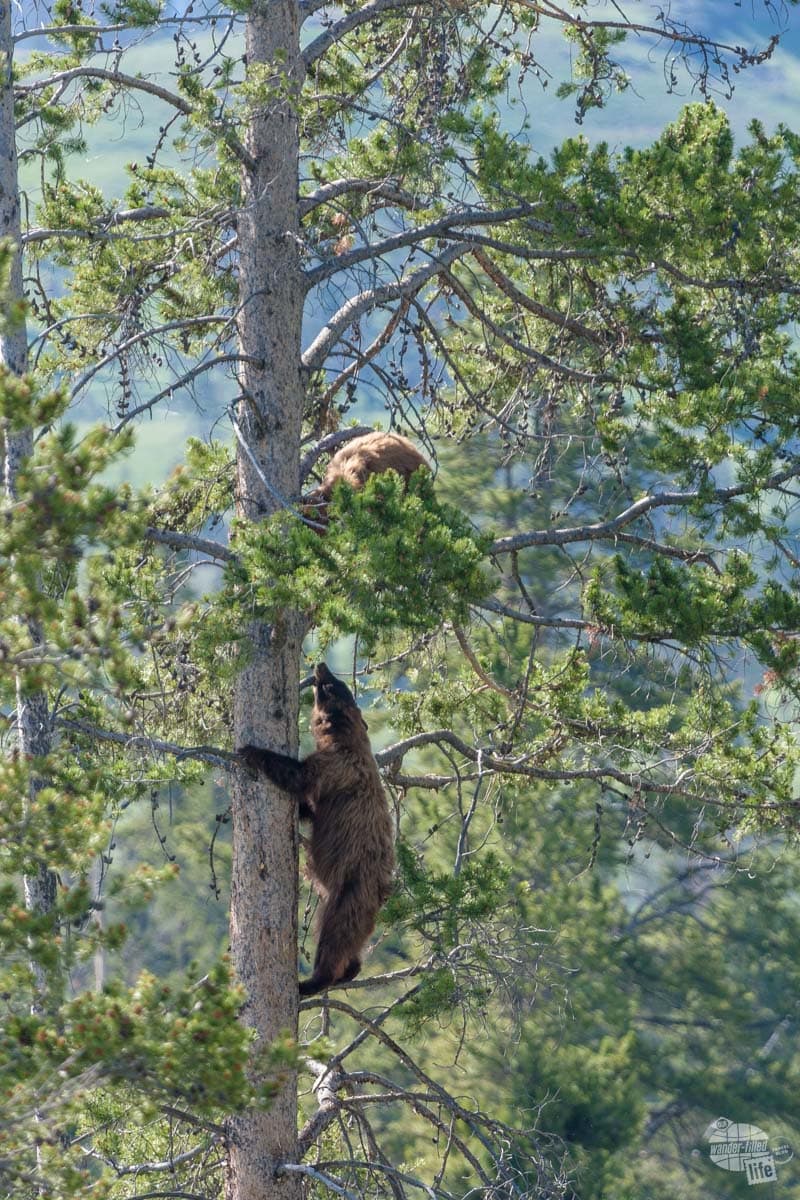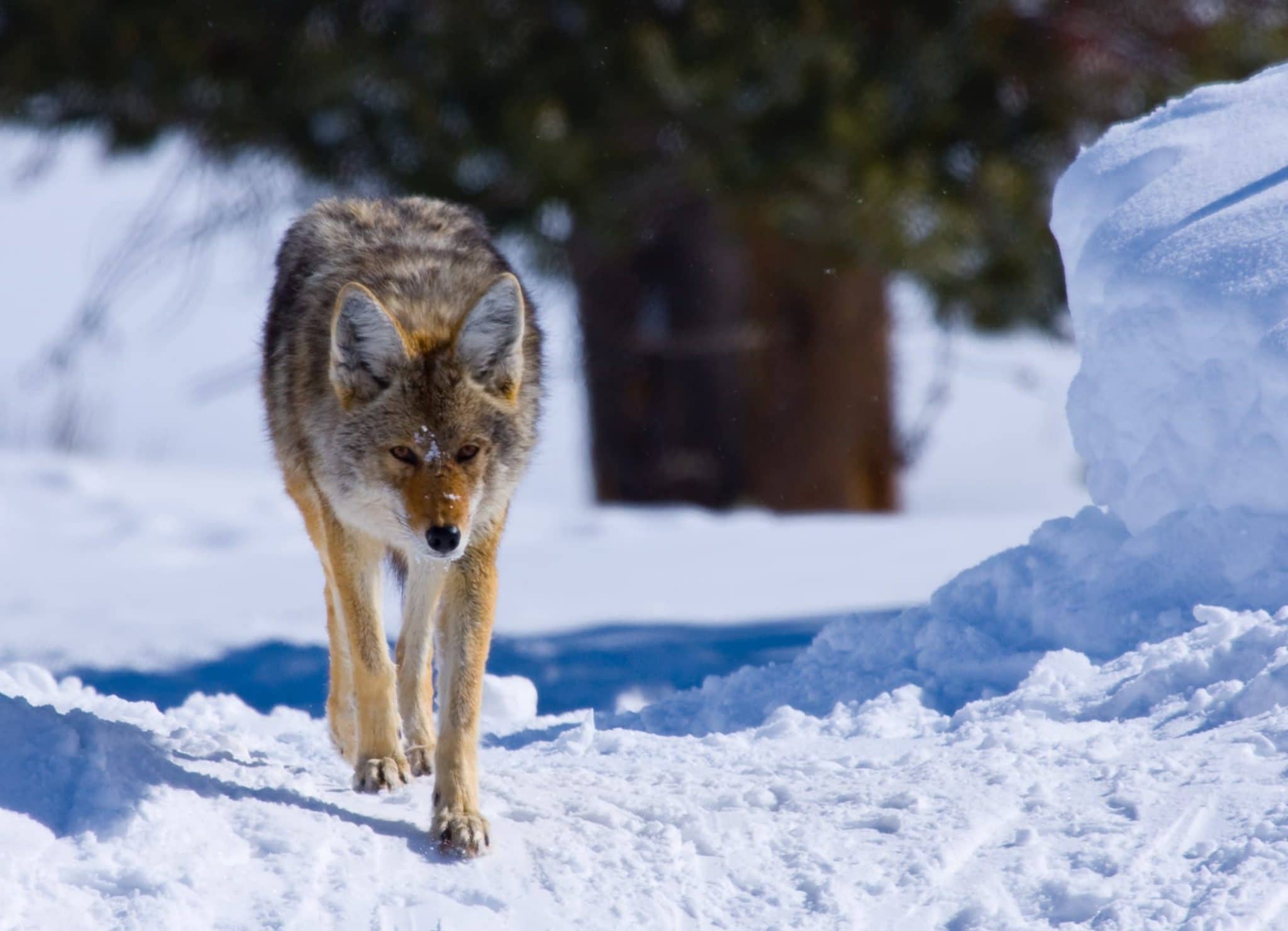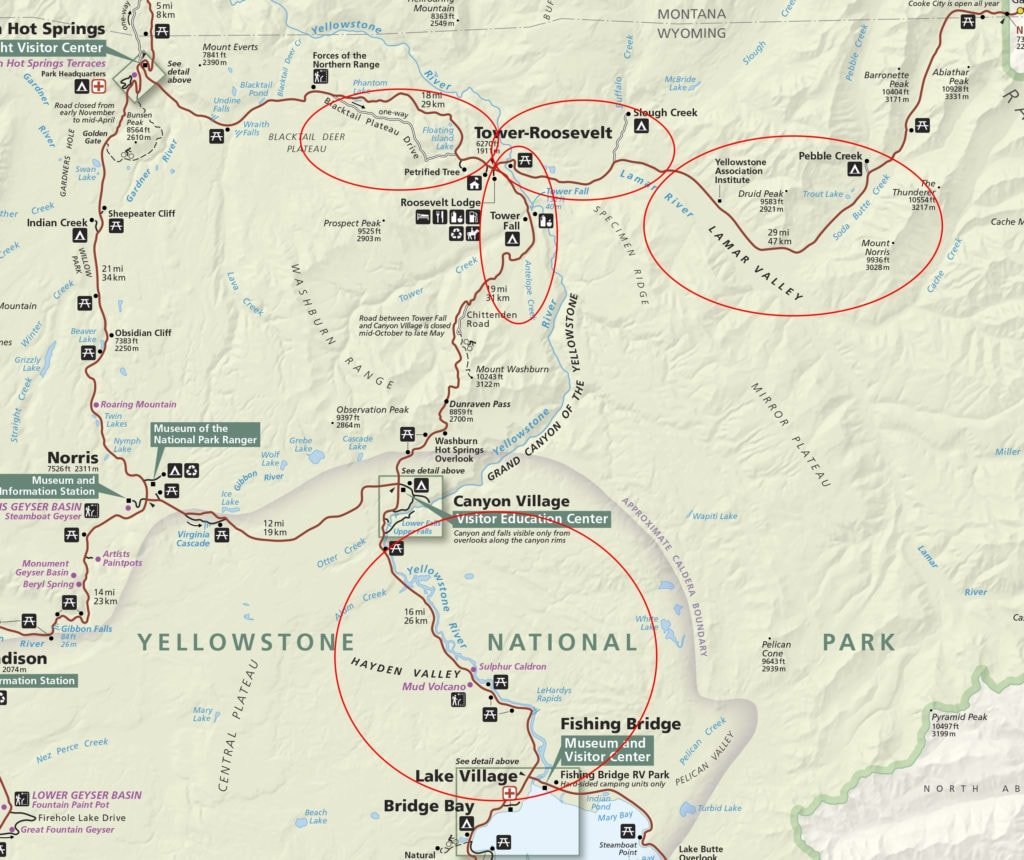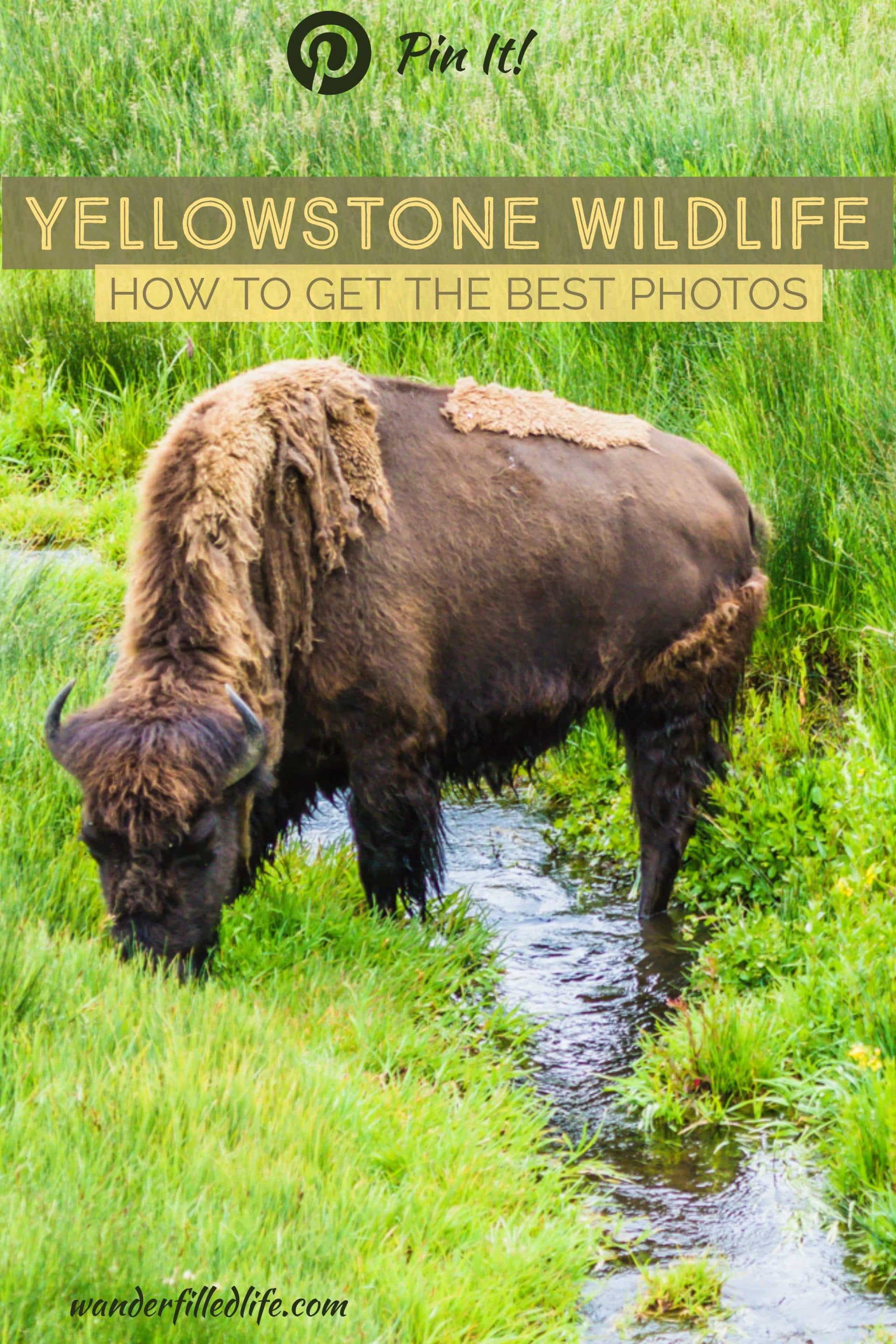Last Updated on February 19, 2024 by Grant
Finding Yellowstone wildlife is one of the main reasons people go to Yellowstone National Park. You will find scores of wildlife roaming the hills and valleys of this wonderland.
There is an overlook in Hayden Valley which always seems to have a crowd. The parking area is always full and folks are camped out there with chairs and spotting scopes.
These are the “wolf peepers,” as I term them… Folks who sit for hours hoping to catch a highly magnified glimpse of a wolf.

I have only seen a wolf once in three previous trips to Yellowstone, albeit at great distance through a very powerful spotting scope. It looked like a gray flash in the sagebrush.
Still, I often check in to see what’s going on. While driving north one evening, we spotted most of the “wolf peepers” up at their scopes. That’s the surefire way to tell something is going on… If the “peepers” are sitting in their chairs, there’s nothing to get excited about. If they are up and looking through their scopes, there’s some excitement… Yellowstone wildlife is always unpredictable, so it is best to check in to see what’s going on.
Bonnie dropped me off (more on that little tidbit in a moment) and I asked the “peepers” what was going on.
“We are watching six wolves move across the valley.”
I quickly got set up, mounting my Canon 100-400mm lens to the monopod and started scanning the valley. They walked me in visually to the wolves, who were moving through high sagebrush. I could barely see the tops of their heads. Fortunately, two of the wolves were black, so they were a lot easier to track.
After parking, Bonnie joined me and used the binoculars to follow along with the action.
Holy cow! I could actually see a defined form of a wolf through my camera lens. This alone was worth the cost of renting this lens. I have only seen a wolf through my camera lens once, in Denali National Park and Preserve in Alaska. Now, I was seeing six!

Then they turned and the chase began! They tore after a herd of elk through the sage. The wolves (I think) took down the littlest/youngest elk just behind a small rise in the valley, just out of line of sight, but still… WOW! OH MY GOD! THAT WAS SO COOL!
(Disclaimer: When we link to places where you can buy our stuff or places we stayed, we are using special codes that earn us commissions on the sales at no additional cost to you. Please see our Review Policy for more information.)
The American Serengeti
I have heard Yellowstone National Park called America’s Serengeti and I couldn’t agree more. It is one of the largest, most wild places left in the continental United States. The sheer amount of Yellowstone wildlife is staggering. There are 67 different species of mammals living in Yellowstone, including more than 100 wolves, nearly 700 grizzly bears and large numbers of black bears, elk, bison, bighorn sheep, deer, and pronghorn. Less commonly, you can find wolverines, lynx, non-native mountain goats and moose.

That’s a lot of Yellowstone wildlife! You can visit several times and not see all of them. Indeed, lynx and wolverines have relatively small populations and, unless you are a backcountry wildlife biologist, you will likely never see them.
Even some of the larger animals can be difficult to find. For example, we have never seen a moose in Yellowstone, much to Bonnie’s chagrin.
Other animals, you will see in great abundance. Elk and bison, for example, are so abundant I can pretty much guarantee if you spend a day driving in Yellowstone, you will see both. I would even bet that you will see them close to the road and in large quantities. Indeed, if you enter the north entrance and head into Mammoth Hot Springs, you will likely find elk hanging out on the grass lawns of the village.

I say this to alleviate the biggest problem we have in Yellowstone: folks stopping on the roads to look at bison or elk. Yellowstone wildlife jams are famous. That said, In most places in the park, there are plenty of places to pull off the road and let folks by. Please. Do this. It will save everyone behind you a headache and keep the rangers from giving you a ticket. That’s right, it’s against the law to block the road.
How to Get Good Yellowstone Wildlife Shots
Be Ready to Take Pictures of Yellowstone Wildlife
One thing Bonnie and I do is designating a photographer (me) to be ready to jump out of the car and go take pictures of Yellowstone wildlife while she parks the truck. This allows me to be mobile and taking pictures. It sucks a bit for Bonnie because sometimes she misses the action, but it is necessary to get the shot. Since Bonnie likes good wildlife shots as much as I do, she is ok with it.

If you want good pictures of Yellowstone wildlife, you have to be ready to jump out and start taking pictures, so have your gear ready and be ready to go.
For more tips on visiting Yellowstone, be sure to check out Bonnie’s article here.
Check out our full Yellowstone Packing List here.
You Will Need Good Gear to Get Great Yellowstone Wildlife Pictures
DSLR Camera Recommendation
Let’s talk about gear for a moment. For best results, I recommend either a DSLR and a high-end zoom lens OR a high-end bridge camera. There is not way around it, if you want professional quality results, you need to use professional quality gear. While your iPhone is a really good landscape camera, it blows when it comes to shooting Yellowstone wildlife.
I shoot with a Canon EOS 7D MkII. It has three custom modes, one of which I have set for shooting wildlife. I bought a Canon EF 100-400 professional-grade lens. I have rented this lens before and I know it is a solid performer for Yellowstone wildlife shots.
- 20.2 MP CMOS sensor and ISO 100-16000
- High speed continuous shooting up to 10.0 fps
- 65-point all cross-type AF system
- Stunning Full HD video with Custom Movie Servo AF (speed and sensitivity)
- Dual Pixel CMOS AF enables you to shoot video like a camcorder
- Compact, high performance L-series super-telephoto zoom makes it ideal for sports and wildlife photography
- Rotation-type zoom ring allows for more precise composition and excellent balance when handholding.Rounded 9-Blade Diaphragm
- Improved zoom torque adjustment ring allows easy setting of zoom tension, Focal Length & Maximum Aperture:100-400 millimeter 1:4.5-5.6, Closest Focusing Distance-3.2 feet; 0.98 meter
- New Air Sphere Coating (ASC) helps to significantly reduce backlit flaring and ghosting, Highly resistant to dust and water, and amazing durability enabling shooting even in harsh conditions
- English (Publication Language)
While the lens is light enough for hand-held shots, I also take a Manfrotto monopod to allow me to get a steadier shot. I keep a spare memory card on my sling and a spare battery in the truck.

I used to keep a digital wallet with me to be able to dump memory cards if I ran into something really cool, but with my new camera, I have slots for two memory cards. Now, I use a 128 GB card as my in-camera back up and two 64 GB cards to shoot with.
Even with a 20-megapixel camera shooting nothing but RAW images, I have never filled a 64 GB card in one day of shooting and it was not until my fifth week of shooting that I filled the 128 GB back-up card.
Pro-Tip: Always carry a back up for both memory cards. You never know when you will spot Yellowstone wildlife doing something really cool and fill up a memory card!
Read more about what I keep in my camera bag here.
Bridge Camera
You can use something like a bridge (also called superzooms) camera for Yellowstone wildlife. There are plenty of folks who use something like the Canon SX70. I had the SX40 and have used it for Yellowstone wildlife and action shots. The great optical zoom on the camera combined with lightweight and low overall cost makes it a good entry-level wildlife camera. A good bridge camera can get you close to Yellowstone wildlife without breaking the bank or the arm.
- Powerful 65x optical zoom
- 203 Megapixel CMOS sensor and DIGIC 8 image processor
- 4K video and 4K time-lapse movie
- 039-Type Approx 236-million dot, OLED EVF
- Use the EOS Utility Webcam Beta Software (Mac and Windows) to turn your compatible Canon camera into a high-quality webcam
If you are planning on shooting with something with a zoom like that, I highly recommend getting a hiking stick with a camera mount screw or a monopod for it. Handholding it at maximum zoom makes it very hard to keep the image steady.

In 2020, I bought the Sony Cyber-shot RX10 IV. Both the lens and sensor are a huge improvement over the SX40, even with the sacrifice of some of the zoom capability. That said, it weighs 68 percent more (39 oz vs 23 oz) and costs about $1,000 more.
There are trade-offs for everything in the camera world! For me, the improvement in the lens quality is worth the trade-off. For a beginner, however, the cost is often a pretty big burden.
All that said, if I were to only take one camera with me anywhere, this is the camera! While I still use my DSLR for Yellowstone wildlife photography, this camera produces images that easily rival it.
Read Grant’s review of the Sony RX10 here.
- World’s Fastest AF acquisition speed of 0.03 sec. Optical image stabilization technology developed by Sony is valuable for handheld still and movie shooting, especially in low light or at the ultra-telephoto end of the zoom range up to 600 mm
- 315 phase-detection AF points covering Approx. 65% of the frame. Light etering mode- Multi pattern, centre weighted, spot (Standard/Large), entire screen average, highlight
- ZEISS Vario-Sonnar T 24-600mm3 F2.4-F4 ultra-zoom Lens
- 20.1 MP 1″ back Illuminated Exmor RS stacked CMOS sensor w/ DRAM. Dimensions (W x H x D) (CIPA) -5 1/4 x 3 3/4 x 5 3/4 inches, 5 1/4 x 3 3/4 x 5 1/8 inches (from front of lens to monitor). Weight-2 pounds 6.7 ounce (Battery and SDXC Card included) / Approx. 2 pounds 5.1 ounces) (Body Only)
- 24 Fps4 continuous shooting up to 249 frames with AF/AE tracking. Filter diameter:62 mm.
Finding Yellowstone Wildlife
Ok, you got your gear ready in your lap, you are sitting shotgun while your dutiful assistant is ready to drive you all around the park. You are ready to jump out, do an A-Team roll and hop up to take pictures. Now what? Where do you go for the action?

The short answer is: it depends. It depends on what you are looking for in terms of Yellowstone wildlife and what time of day it is.
The best times to find wildlife, any Yellowstone wildlife, are in the mornings and evenings. Seriously, get up early, go out looking for wildlife, then eat breakfast. When you get done sightseeing for the day, have an early dinner, then go back out to look for wildlife. Just be careful driving at dawn/dusk… Yellowstone wildlife, particularly elk and deer, have a tendency to just step out into the road.

My second suggestion is to avoid hot days. If the temperature is above 80 degrees, you will find that the Yellowstone wildlife is bedded down in the shade, not out roaming. Back in 2014, the Fourth of July was really hot. We saw no Yellowstone wildlife at all… save one grizzly bear hanging out in a creek, cooling off.

Bison and Elk
You can find both of these animals just about anywhere in the park. Seriously, anywhere. If you are looking for herds, I suggest either Lamar Valley or Hayden Valley.

Wolves
Wolves eat elk, among other things, so if you are looking for wolves, look for their prey. Both Lamar and Hayden valleys offer long views which make spotting the elusive creatures easier.
When looking for wolves, be sure to check in with the “wolf peepers.” These folks stay out in the park for days on end and know the behaviors of the various packs better than anyone.

If seeing a wolf is your main goal for coming to Yellowstone, I suggest bringing chairs to sit on, a spotting scope, tripod and plenty of snacks. It takes a lot of patience (or, in my case, luck) to spot a wolf.
Black Bears
We spotted a large number of black bears this time around, most of them north of Dunraven Pass up to the Tower-Roosevelt Junction. We also spotted them near Mammoth Hot Springs (see Bonnie’s article on seeing them on a trail) and, in the past, on Blacktail Plateau.

Bears are pretty easy to spot versus bison or elk. At least in the summer, they are always moving. Whereas bison will stay in one spot and munch, bears are constantly moving around and foraging.
On one day in 2014, we spotted a male black bear chase a female up a tree, then get run off by a larger male. The larger male went up the tree and brought the female down the tree, who promptly rebuffed his advances. He got tired of being rejected and left, with the female chasing after him.

Grizzly Bears
We have found grizzly bears are, more often than not, a little further south in the park. We have seen them in Hayden Valley and along the road towards Fishing Bridge. According to some of the books we have read, Pelican Valley, east of Fishing Bridge, is some of the best grizzly habitat in the world. The trail in Pelican Valley was closed until July 4 this trip due to bears.

One of the difficulties with bears is telling the difference between a grizzly bear and a brown, or cinnamon, black bear. Most of the time, the shoulder hump (grizzlies have a prominent hump on its forward shoulders) will distinguish the two, but even then, they can be difficult to tell apart.

Pronghorn and Bighorn Sheep
You will find the pronghorns in Lamar Valley from time to time in the summer. This was the first trip we have seen them, but the park typically has a couple hundred pronghorns.

Bighorn sheep are harder to spot in the summer. They tend to spend their time on the rocky cliffs above. In the winter, however, they come down into the valleys to feed. We spotted plenty of Bighorn sheep in Lamar Valley when we visited back in February 2011 and along the Shoshone River outside the park in December 2015.

On our most recent trip in Fall 2003, we spotted several Bighorn sheep ewes near Tower Falls.
Read more about our Fall trip to Yellowstone and Glacier national parks here.
Coyotes and Foxes
We have spotted coyotes near the Tower-Roosevelt Junction. Indeed, on our horseback ride, we rode past a coyote den with pups. If we had more time on this last trip, I would have hiked out there to take pictures, but alas, the horseback ride was our last evening in the park.

Foxes are tougher to find. We spotted one once on Dunraven Pass and another close to Hayden Valley, but they are tough to find. They can typically move through the sagebrush without being seen.
Other Yellowstone Wildlife
There are plenty of other Yellowstone wildlife. Be sure to check the NPS Web site for more information.

We have spotted marmots by Sheepeater Cliffs. I have some great pictures of both osprey and bald eagles I have found in various spots throughout the park.
On this latest trip, we found both bald eagle and osprey nests and were able to take pictures of both nesting birds. That was really cool!




Final Thoughts on Yellowstone Wildlife
I know we have said this a lot and I know the accommodations inside Yellowstone can be hard to come by, often requiring reservations months in advance, but stay in the park. Indeed, I recommend staying in the middle of the park.
Roosevelt Lodge or Slough Creek Campground (apparently there is a wolf den nearby) would be my choice for staying on the north end of the park. Canyon Lodge/Campground is a good central location. Bridge Bay Campground, Fishing Bridge RV Park or Lake Lodge are good options a little further to the south. In general, the east side of the park is better for Yellowstone wildlife than the west side.

The key to spotting Yellowstone wildlife from the roads is patience and timing. Make sure you spend your evenings and early mornings checking the usual spots… Hayden Valley, Dunraven Pass north to Roosevelt-Tower Junction, Blacktail Plateau and Lamar Valley.
Talk to rangers and do so in all of the visitor centers. Yellowstone is really big, so a ranger in Mammoth Hot Springs may not have good information on Yellowstone wildlife in Hayden Valley, but a ranger in Canyon or Fishing Bridge might.

Don’t be afraid to get out and hike to a good Yellowstone wildlife spot, or just hike in general… You never know what you will find.
Most of all, get out and enjoy the living story Yellowstone wildlife has to tell.
Travel Resources
What do you use to find a flight?
We use Skyscanner to find deals on flights. Skyscanner has a great interface and compares tons of airlines for the best pricing and routing. That said, it does not always have every airline and some airlines will have better deals on their website. Still, Skyscanner is a great place to start.
Click here to search for a flight.
What do you use to find a hotel?
We typically stay at Hilton properties, so we use the Hilton website. You can find good Hilton Honors discounts or AAA discounts for a hotel there. We make great use of our free night certificates from our Hilton Honors American Express.
Click here to book a Hilton property.
If there are no Hilton properties available, we use TripAdvisor to read reviews and book the hotel. We find we can get the best price that way.
Click here to search for a hotel.
We recently partnered with Stay22 to add interactive maps to each of our destination posts. This will allow you to see a plethora of hotels and vacation rentals all in one responsive map of the area.
What if I need more space than I can get at a hotel?
We use Vrbo for the times when we have rented a cabin for a weekend getaway, like this cabin in Townsend, TN, or needed to rent a house for a large family vacation. We had a great experience with them in terms of refunding deposits when COVID hit and will continue to use them.
Click here to search for a vacation rental.
Who do you use for rental cars?
As a general rule, we book with Hertz for rental cars. We have had nothing but good experiences with them. Plus, we really like unlimited mileage and not worrying about crossing state lines. We have even rented from Hertz overseas in both Slovenia and Croatia.
Click here to book a rental car.
How about booking a cruise?
We have found some amazing prices for booking a cruise through Cruise Direct. We have saved a lot of money on our cruises compared to what we found elsewhere, making a last-minute Bahamas cruise even cheaper.
Click here to book a cruise.
What if I want to rent an RV?
We highly recommend Outdoorsy for RV rentals. We rented a camper van for a week to visit Rocky Mountain National Park for the elk rut and Custer State Park for the Buffalo Round-Up and had a blast. The program was easy to use and we really enjoyed the freedom of having a camper van for that trip.
Click here to rent an RV.
What do you use for booking tours?
We don’t often book tours. Typically, we like to do stuff on our own. That said, there are some experiences you can’t have any other way. So, when we do want to book a tour, we always check Viator first.
Click here to book a tour.
Do you use anything to get discounts on the road?
We make extensive use of both Good Sam and AAA on the road. Good Sam is normally regarded as a discount card for RVers at campgrounds and Camping World but anyone can use the 5 cents off a gallon at the pump at both Pilot and Flying J.
Click here to get a Good Sam membership.
We have had AAA as long as we have been married and it has more than paid for itself in discounts at hotels, aside from the peace of mind of having roadside assistance. Add in paper maps and the ability to get an international driver’s license and it is more than worth it for any traveler out there.
Click here to get a AAA membership.





